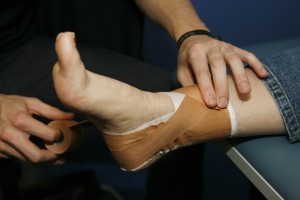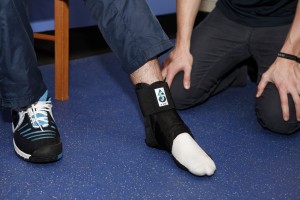- Ankle injuries are one of the most common injuries in netball.
- A minor sprain (tear of part of one of the ligaments in the ankle) may only require a week off training and treatment from a Physiotherapist to help decrease the pain and swelling.
- Evidence indicates that Physiotherapy intervention within seven days of an ankle sprain yields significant benefits in ankle function at 2 weeks and quicker return to sport.
- A severe ankle ligament sprain may require 6-10 weeks off netball and may require months of rehabilitation exercises.
Factors that increase the risk of an ankle spra in include:
in include:
- Previous history of an ankle injury
- Not stretching prior to training
- Wearing shoes with too much cushioning in the heels which may decrease proprioception.
Common Questions:
Will wearing bracing/taping decrease risk of injury?
Several studies recently have shown that wearing an external ankle brace or taping decreases the risk of spraining the ankle, especially if there is a history of an ankle sprain. Different people will need to use different methods of taping dependant on their foot shape and if they have had a sprained ankle before. It is important to ask a Physiotherapist what taping/support is most appropriate for your ankle as poorly applied or inappropriate taping is ineffective.
Will exercises help to decrease the risk of ankle injuries?
Training the body to sense the position of the ankle and to react quickly to any change in position is very important in preventing repeat ankle injuries. This is known as proprioceptive training and is especially important after an ankle injury as these reactions don’t come back automatically. There is evidence that proprioceptive training helps to prevent future ankle sprains and knee injuries. The training involves progressively challenging the body’s balance system by modifying floor surface, base of support and level of visual input. There are many variations of this sort of training which can be incorporated into a team training session.
Should I wear an ankle brace or taping if I have never injured my ankle?
There is no evidence to support the use of ankle taping or bracing in an athlete who has never sustained a previous ankle injury.
Will wearing an ankle brace or tape weaken my ankles?
Taping and bracing are designed to limit excessive movement at the ankle joint. If applied correctly, both taping and bracing should allow normal movement to take place, which will in turn allow normal muscle activity to occur around the joint and maintain normal strength within those muscles. Therefore tape or braces are an extra helper to your ankle’s normal protective mechanisms as you return to play following injury.
Won’t ankle taping or bracing simply pass the injury on to a higher joint such as the knee?
There is no evidence to support this. Ankle taping simply acts as a support to normal functional ankle movement.
So, to tape or to brace??
Research shows that either option helps to prevent recurrent ankle sprains as long as you are using them correctly. So choose the right option for yourself and don’t forget to do some “proprioception” training.
TAPING
There is a certain skill to effectively taping an ankle joint for injury management or rehabilitation. Effective taping must be applied in a manner that allows normal movement to occur while restricting unwanted, excessive movement. Taping takes practice and usually requires some instruction from a qualified Physiotherapist or sports trainer. Taping does take time and must not be rushed. Preparation prior to a game or training session is important to allow enough time to apply the tape properly. When taping an ankle, it is recommended that a rigid or elasticised semi-rigid tape be used to provide the best support and to limit the joint at extremes of range. Tape costs between $10-$15 per roll and should provide enough tape for around four ankles. Across a season this may become somewhat expensive, but if done properly will provide the maximum amount of support to the ankle joint. Note: some people may be allergic to the tape adhesive so hypo-allergenic underlay should be used if appropriate.
BRACING
There are a large number of devices available from chemists, sports medicine centres and clinics that may be referred to as “braces”. Not all of these are appropriate for providing support or extra stability to ankle joints. Elasticised, slip-on supports help to keep a joint warm and compressed, but provide very little assistance to the stability of that joint. A well designed ankle brace will usually consist of a lacing system, some rigid or semi-rigid stays on the sides of the brace, a Velcro strapping mechanism and be constructed of a sturdy material. They are quick and easy to apply and allow little room for error with their application, meaning little or no training is required for their use. Braces don’t offer quite the same degree of support as taping but will be suitable for almost anyone. Most ankle braces retail for between $75 and $100 and if looked after should last a minimum of twelve months before needing replacement. Braces are claimable through some ancillary private health insurance plans.
Precautions:
- Ankle bracing and taping should not be used in place of aggressive rehabilitation, including strengthening and proprioceptive exercises. Rather, both should be used in conjunction with rehabilitation in terms of injury prevention.
- Loosening and slippage can be a common problem if not fitted correctly, causing increased risk of injury. Braces should therefore be fitted by a duly qualified professional.
Physiotherapists at Rathmines Physiotherapy and Sports Injury Centre are available to instruct clients on the appropriate taping method for their condition. Appropriate braces can also be fitted and purchased from the centre. For an appointment, please call (02) 4975-1622.















